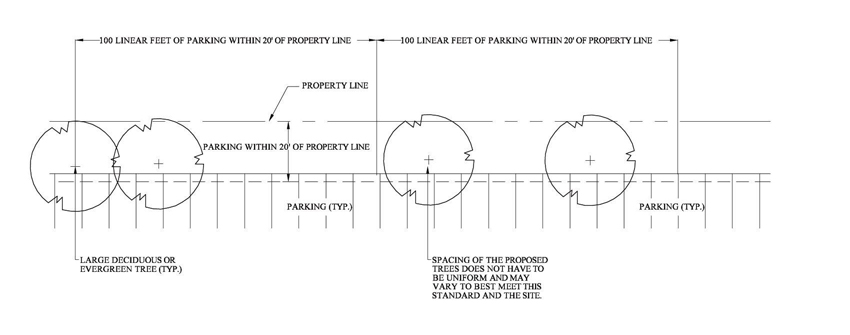Subpart B. Parking Lot Landscaping Standards
The landscaping standards of this subpart provide requirements for all parking lots consisting of ten (10) or more spaces. The following standards shall be in effect for each parking lot of this size, and compliance therewith is required for the establishment of a new or expansion of an existing parking lot.
For every five (5) parking spaces one (1) small or large deciduous tree shall be required. Plant material shall be placed within the parking lot or within 20 feet of the perimeter of the parking lot. All parking spaces shall be within 60 feet of a tree, as measured from the tree trunk to any portion of a parking space.
When no buffer is required along front, side, and rear property lines of a development and parking is proposed within 20 feet of said property lines, a planting strip is required. The planting strip shall be a minimum of ten (10) feet in width and shall contain two (2) small or large deciduous or evergreen trees per 100 linear feet (see Figure 5A). A planting strip design may include small and large deciduous and evergreen trees and shrubs. For the purpose of a planting strip, six (6) shrubs shall be considered equivalent to one small or large deciduous or evergreen tree.
Figure 5A. Planting Strip
Not to Scale, Dimensions May Vary

When parking lots contain multiple bays of parking, parking islands shall be installed and one-third (1/3) of the required plant material for the parking lot shall be placed within the islands. A parking island shall be a minimum area of 130 square feet per tree and a minimum width of eight (8) feet (measured from back-of-curb to back-of curb or edge or pavement to edge of pavement). Flat curbed islands or islands with curb cuts designed to be used as bio- retention areas (for treating stormwater runoff) should be used, where possible.
Plant material placed within six (6) feet of the edge of pavement must be bermed or have installed wheelstops or bollards to ensure that parking/moving cars do not damage the plant material. The Zoning Administrator may approve other methods to protect plant materials on a case-by-case basis.
